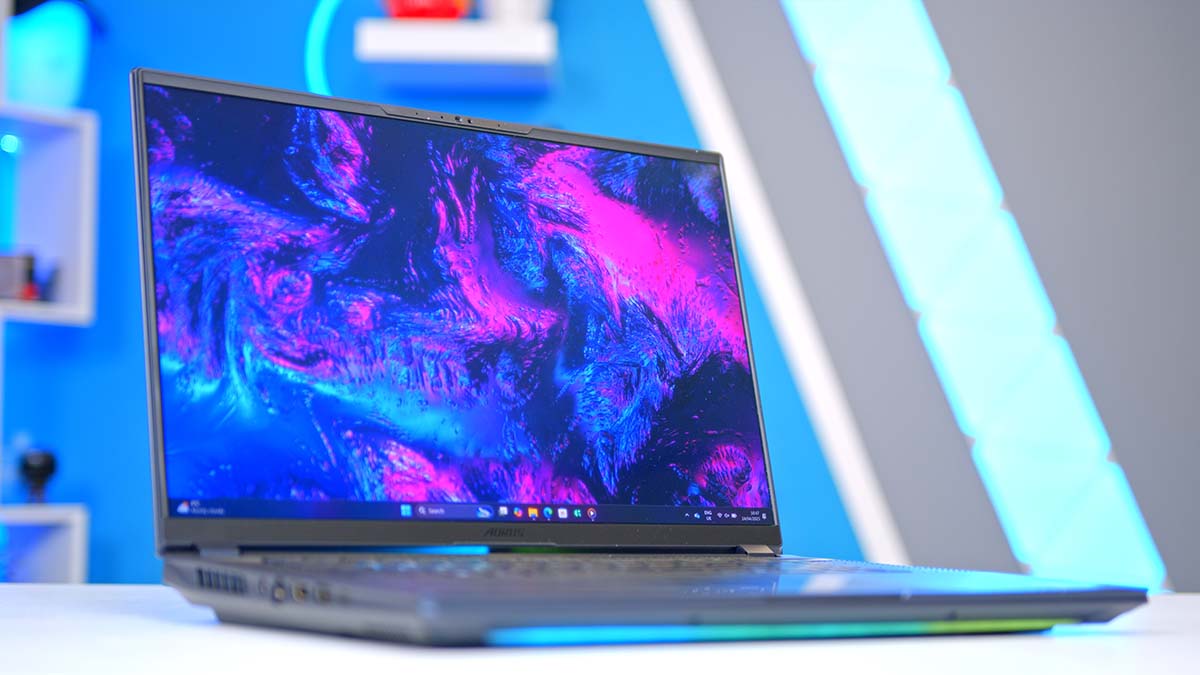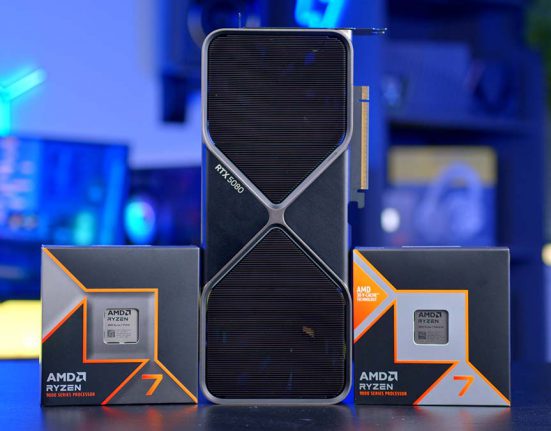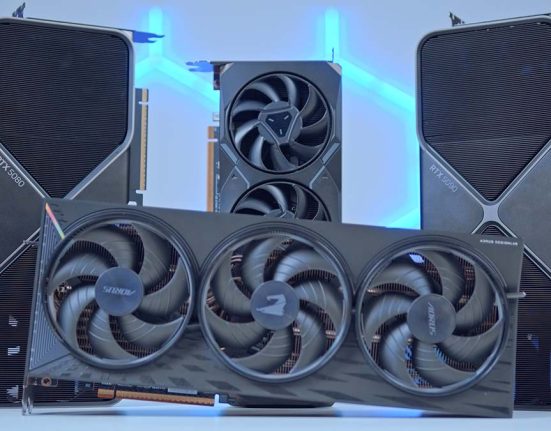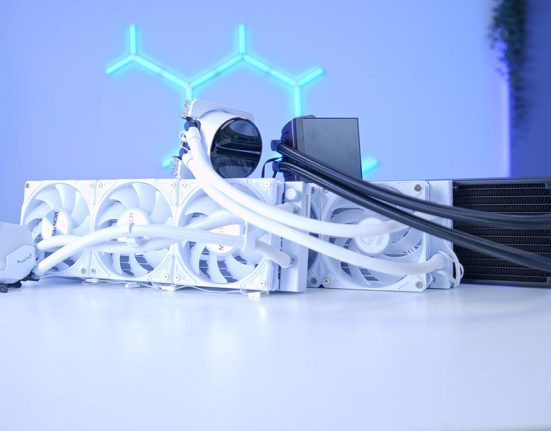The Gigabyte AORUS MASTER 16 is a gaming laptop with some of the highest specs we’ve seen in quite some time. This beast of a machine is equipped with an Intel Core Ultra 9 275HX and an NVIDIA GeForce RTX 5080 Laptop graphics card. These two components alone handle the vast majority of the horsepower in this laptop, and these are highly powerful on paper.
But the big question we always have with any gaming laptop review is, how does it perform? Naturally, gaming laptops are up against fierce competition, as it’s becoming increasingly more challenging for laptop hardware to offer decent metrics in modern games. Even with the assistance of DLSS and Frame Generation, laptops like the AERO X16, which has an RTX 5070, struggled significantly with 1440p. That’s why we’ve put the AORUS MASTER 16 through the wringer with plenty of benchmarks to determine if this gaming laptop is up to the task regarding gaming and workstation loads.
In this review, we explore the AORUS MASTER 16’s specs, design, performance, and features to determine whether it’s a worthwhile purchase in the current market.
Buy the Gigabyte AORUS MASTER 16 on:
Specification
The Intel Core Ultra 9 275HX is at the core of this laptop. This laptop’s CPU is part of the Core Ultra range and is one of the fastest non-desktop processors you can squeeze into a compact chassis. It has 24 cores and threads clocked at a max boost speed of 5.4GHz. It has a maximum power draw of around 160W, so it can run quite hot, depending on the circumstances.
The RTX 5080 handles all of the graphical load. As we’ve mentioned in other laptop reviews, laptop GPUs are not the same as their desktop counterparts, as a different type of silicon is used because it needs to be able to handle higher temperatures, which is one of the main constraints of laptops. This means that the RTX 5080 will likely perform worse than a standard RTX 5080, for which we’ve provided some numbers in the benchmarking section.

Regarding RAM and storage, the AORUS MASTER 16 supports a maximum of 64GB of DDR5 clocked at 5600MT/s. For storage, there are two M.2 slots, one Gen5 and one Gen4, of which both can hold a max capacity of 4TB each. The laptop that Gigabyte kindly sent us is only equipped with 32GB and a 1TB drive. The RAM capacity I can understand, but it is disappointing that the drive in this laptop isn’t 2TB. Based on the size of modern games, it will be pretty tricky to install much on this machine due to a lack of space.
While the AORUS MASTER 16 isn’t a gigantic laptop, it’s no surprise to see such a strong spec equipped with a wide selection of IO. There are four USB ports, two USB 3.2 Gen2 Type-A ports, and Thunderbolt 4 and 5 Type-C ports. While there aren’t many devices compatible with Thunderbolt 5, this will set up many users for future component upgrades that support the Thunderbolt 5 spec.

Both Thunderbolt ports support DisplayPort inputs, but you’ve also got access to an HDMI 2.1 port, a standard Gigabit Ethernet adapter and a 3.5mm combo jack for a headset or headphones. Additionally, this laptop also supports WiFi 7 for networking, so if you’ve got a supporting router, you can utilise incredible speeds and stability across the board.
This laptop’s screen offers an incredibly vibrant display. It maxes out at a resolution of 1440p with a refresh rate of 165Hz, which is well beyond the 144Hz mark we typically expect from most gaming machines. The main kicker to be aware of with the display on the AORUS MASTER 16 is that it’s OLED, instead of more traditional IPS and TN panels. This allows you to enjoy games, films and more in high visual fidelity with minimal drawbacks. OLED monitors provide crisp and vibrant imagery, and while this component is likely one of the primary sources contributing to the price, it’s worth it for many gamers and content creators.
| Key Specs | Gigabyte AORUS MASTER 16 |
|---|---|
| Processor | Intel Core Ultra 9 275HX |
| Graphics Card | NVIDIA GeForce RTX 5080 Laptop GPU |
| Memory | Up to 64GB DDR5 5600MT/s RAM |
| Storage | Up to 1 x 4TB PCI-E Gen5 M.2 SSD Up to 1 x 4TB PCI-E Gen4 M.2 SSD |
| USB Ports | 2 x USB 3.2 Gen2 Type-A 1 x Thunderbolt 5 Type-C 1 x Thunderbolt 4 Type-C |
| Additional IO | 1 x HDMI 2.1 1 x DisplayPort 2.1 (Type-C) 1 x DisplayPort 1.4 (Type-C) 1 x RJ-45 1 x Audio Jack |
| Display | 16″ OLED WQXGA (2560 x 1600) 240Hz |
| Networking | WiFi 7 Gigabit LAN |
| Operating System | Windows 11 Pro |
| Battery Life | 99Wh |
Last but not least is the operating system and battery life. The AORUS MASTER 16 has an activated copy of Windows 11 Pro. While the advanced features won’t be helpful to everyone, Windows 11 Pro offers some extra security features that can provide additional protection. The battery has a 99Wh capacity and can fast charge to 50% in 10 minutes. Depending on your usage, the 99Wh capacity will last you a few hours, but this will vary based on the complexity and length of the tasks.
In terms of price, the AORUS MASTER 16 is £2899.99 in the UK, which converts to $3800 in the US. Compared to the rest of the market, this is one of the more expensive gaming laptops that we’ve reviewed. While the AORUS MASTER 16 looks solid on paper, the easiest way to determine if this laptop is worth its price point is with some gaming benchmarks, which we’ll look at later on.
Gigabyte AORUS MASTER 16 Design
Taking a look at the design, the AORUS MASTER 16 is fairly similar to the Gigabyte AERO X16. This is a 16-inch laptop with a dark, slimline chassis offering plenty of RGB around the outer shell. Gigabyte has gone for a fairly stealthy approach on the outside, with a carbon-fibre look on the upper lid, and a shining RGB logo once the laptop is powered.

Once opened and switched on, the AORUS MASTER 16 shows its true colours, offering vibrant lighting across the keyboard. It also has a strip on the bottom frame and a projector underneath the screen that showcases the AORUS text.

The sheer amount of RGB across the design tells you that this is a gaming laptop through and through. This does mean it might not appeal to those looking for a machine that’s a bit more subtle in terms of style. However, if you’re looking for a portable system that’s pretty snazzy, the AORUS MASTER 16 is a showpiece.
The laptop’s RGB lighting is fully customisable and can be easily configured within the Windows Dynamic Lighting application. Additionally, ‘QWERASD’ keys are coloured differently from the rest of the keys, providing an easy way to find your gaming keys in low-light situations.

Regarding airflow, the AORUS MASTER 16 has vents across the side, rear, and bottom to ensure that the laptop stays cool under load. The cooling system under the hood utilises two blower-style fans that push the majority of the hot air out of the bottom. This is a fairly standard design, but it does mean that most of the hot air will be blowing onto your legs, which can get uncomfortable over a prolonged period.

Overall, I like the design of the AORUS MASTER 16. This laptop is relatively compact, and despite weighing around 2.5kg, it doesn’t feel that heavy and can easily slip into a bag without issues. I like that Gigabyte has embraced the gamer aesthetic regarding the livery and RGB lighting. My one qualm is that the hot air is pushed out of the bottom instead of the sides. This makes the user experience fairly uncomfortable over time, as you’ll have hot air blown onto your legs while gaming and working.

Benchmarking & Gaming Performance
We’ve put it through the wringer in a series of synthetic and gaming benchmarks to get an idea of how this laptop performs and handles various workloads. The synthetic benchmarks test the CPU and GPU individually to provide an overview of how they handle workstation tasks. The gaming benchmarks offer some framerate metrics to see how the AORUS MASTER 16 handles modern titles.
CPU-Z
The first synthetic benchmark is CPU-Z, which tests several different thread configurations and assigns a score. We also have HWMonitor running in the background to see where temperatures sit. After running the benchmark for a few minutes, the score finally settled down with a final output of 11523. For context, this puts it just above the Ryzen 9 7900X3D, according to CPU-Z’s scoreboards.
Temperature-wise, it was a bit all over the place. When we ran the initial benchmark, we saw a spike up to 90°C, but when the benchmark managed to maintain a consistent score and hold it there, temperatures sat at a much more palatable 69°C, with slight increases up to 71°C. You can definitely hear the fans and the cooling system dial up in this benchmark, but it wasn’t to the point of being obnoxious. Temperatures in this benchmark were pretty surprising, and it’s good to see that a high thread count workload won’t turn the AORUS MASTER 16 into an oven.
Furmark
In our Furmark test, temperatures were much more volatile. We saw lows of 70°C with spikes up to 86°C and, in rare cases, even 90°C. It’s fairly clear from this benchmark that the graphics card requires a bit more juice from the fans to maintain lower temperatures, which explains the huge ramp in noise compared to our CPU-Z run. While the AORUS MASTER 16 was hot in this benchmark, the fans were putting in the work to ensure minimal throttling.
Score-wise, Furmark reported an average of around 130FPS. There were some drops to 127FPS, but generally speaking, the RTX 5080 laptop card sat around 130FPS, which is a far sight better than the AERO X16 that we also tested in Q2 of 2025. So far, from the synthetic benchmarks alone, the performance is shaping up to be pretty good.
Cyberpunk 2077
After the synthetic benchmarks, we fired up Cyberpunk 2077 and ran the game at 1440p high settings with DLSS and Frame Generation enabled. On average, the RTX 5080 sat around 158FPS with some drops and peaks here and there. Even as the benchmark moved out into the open world with population density, lens flares and much more to render, this laptop held up incredibly well.
Cyberpunk 2077 can be a challenging game to run at times, as we’ve seen in our review of the AERO X16 laptop. However, the RTX 5080 is putting in the work here and with the assistance of DLSS and Frame Generation, you can enjoy buttery smooth framerates across a massive range of games.
Hogwarts Legacy
The strong performance continues in Hogwarts Legacy. Again, settings were dialled up to 1440p high with DLSS and Frame Generation enabled. In this benchmark, we saw an average framerate of around 170-175FPS. There were a few drops below the 170 mark, but generally, the AORUS MASTER 16 held firmly around 170FPS, give or take a few frames.
This isn’t the easiest game to run, and we’ve seen Hogwarts Legacy use a fair bit of VRAM in previous benchmarks, so the 16GB available on the RTX 5080 laptop card is paying dividends. With the OLED screen, playing this title is an absolute dream and a super smooth experience across the board.
Features We Like
Excellent Gaming & Visual Experience
It’s incredibly clear from our performance benchmarks and from using this laptop for a few days that it’s a gaming machine through and through. The 1440p OLED screen combined with the hardy performance from the Intel Core Ultra CPU and RTX 5080 GPU provides an all-around excellent experience for gamers. Visuals feel crisp, bright, and radiant, and the games that we’ve played ran as smoothly as butter.

Great Audio Quality
One of my biggest qualms with most laptops is that they tend to use pretty poor speakers or position them awkwardly so the sound won’t come through correctly. However, Gigabyte has put some solid speakers in the AORUS MASTER 16. These are downfiring, so the sound will be coming from the bottom of the laptop, but because the speakers and amp are higher quality than other laptops, the sound still feels well-rounded.

You don’t get the tinny or crackling noises found with most traditional laptop speakers. Instead, you can hear the bass, mid, and high-end frequencies, which is impressive for a laptop. The speakers are also quite loud, so you can feasibly listen to music or a movie and enjoy decent-quality sound that won’t take away from the overall experience.
Features We Don’t Like
RGB Lighting Can be Distracting
One of my issues with the AORUS MASTER 16 is that the RGB lighting can be quite distracting when playing games or watching a film. I generally like the design of this laptop, but the RGB is so vibrant that you can see it reflect on the bottom half of the screen. Unfortunately, there isn’t an easy way to find a compromise with this problem. I had to navigate to the Windows Dynamic RGB lighting settings and crank the brightness down until the RGB wasn’t visible.

I think Gigabyte would have been better off providing a function key that switches off the RGB so it can be done on the fly, or having the RGB brightness automatically lower when gaming. It’s not a deal-breaker, but it would have been ideal if there were a way to lower the brightness quickly instead of having to change it in the Windows OS settings every time I happen to play a game.
GiMate is Gimmicky
As I’ve addressed in our review of the Gigabyte AERO X16 Copilot+ laptop, GiMate is in a state where it isn’t particularly useful. It doesn’t offer enough in terms of customisation to warrant me using it, and it also isn’t quick enough for me to consider using it as a shortcut instead of navigating to a setting and changing things myself. I like the concept, but it simply needs more time in the oven.

While I can appreciate that the current market is heavily focused on AI, too many manufacturers are falling into the trap of providing ‘AI features’ that don’t offer much or are actually useful. But I think with some time, GiMate could be beneficial and help gamers or professionals change quick settings on the fly without a second thought.
Conclusion
Gigabyte AORUS MASTER 16

Product Name: AORUS MASTER 16
Brand: Gigabyte
-
Features
-
Design
-
Performance
-
Value For Money
Summary
The Gigabyte AORUS MASTER 16 is one of the most powerful laptops we’ve reviewed. Equipped with an Intel Core Ultra 9 275HX, an NVIDIA RTX 5080 laptop GPU and a 1440p OLED screen, the AORUS MASTER 16 is designed to be used for high-fidelity work, or gaming at high settings in your favourite AAA and Esports titles. During the time I’ve had with this laptop, I was impressed with the gaming and workstation performance, the speakers offer crisp and clean audio, the keyboard feels responsive and pleasant to type on, and the design is well thought out offering plenty of RGB lighting for those that like to carry around a portable disco machine. Additionally, the OLED display is the cherry on top, bringing everything together and allowing you to enjoy superb visual fidelity while gaming or working.
However, this comes with a significant caveat. The AORUS MASTER 16 is a nearly $4000 laptop. Yes, you read this correctly. Gaming laptops have become increasingly more expensive over the years as manufacturers offer better components designed to go head to head with a desktop machine, but you get the added benefit of portability and several other qualities. If you’re in the market for a high-performance gaming laptop and have plenty of cash to spend, the AORUS MASTER 16 is a no-brainer. However, suppose you don’t need the portability. In that case, we recommend either buying a prebuilt or building your own desktop machine, as it’ll save you a fair amount of money compared to this behemoth of a laptop.
Pros
✅ Gorgeous and vibrant OLED screen
✅ Excellent performance
✅ Crisp and clean sound
Cons
❌ Very expensive
❌ GiMate is gimmicky
❌ RGB can be distracting






![MPI_[DP055] SAMA V60 + 9070 Build Montage](https://geekawhat.com/wp-content/uploads/2025/12/FI_DP055-SAMA-V60-9070-551x431.jpg)

